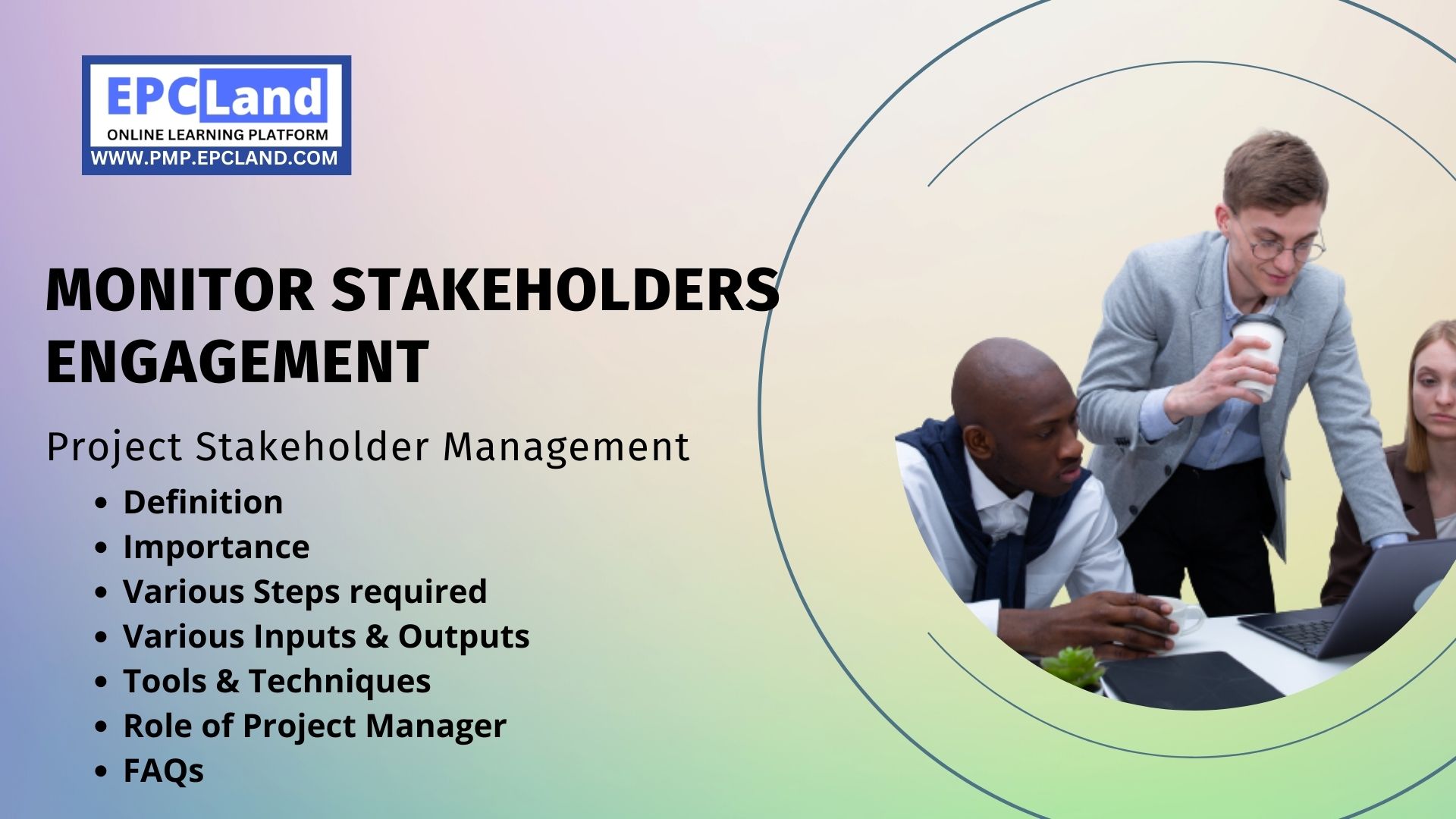Monitoring stakeholder engagement is a critical aspect of project management. It involves regularly assessing the level of involvement and satisfaction of stakeholders and taking steps to increase their participation and engagement. Effective stakeholder engagement helps ensure the success of a project by ensuring that all stakeholders’ needs and interests are taken into consideration. This includes everything from project goals and objectives, to the allocation of resources and the resolution of conflicts. In order to effectively monitor stakeholder engagement, project managers must have a clear understanding of the stakeholders involved, their goals, and how they are impacted by the project. By regularly monitoring and adjusting the engagement strategies, project managers can increase stakeholder satisfaction and achieve project success. With the right approach, monitoring stakeholder engagement can be a powerful tool in ensuring project success.
What is the Importance of “Monitor Stakeholders Engagement” in Project Stakeholder Management
The importance of monitoring stakeholder engagement in project management lies in the following key points:
- Improved Project Outcomes: Monitoring stakeholder engagement allows project managers to assess the level of participation and satisfaction of stakeholders. This helps to ensure that all stakeholders are aligned with project goals and objectives, and that their needs and interests are being taken into account. As a result, the project is more likely to be successful and deliver the desired outcomes.
- Increased Stakeholder Satisfaction: By regularly monitoring stakeholder engagement, project managers can identify and address issues early on, ensuring that stakeholders are satisfied with the project. This helps to build trust and foster positive relationships, making it easier to work together to achieve project goals.
- Better Resource Allocation: Monitoring stakeholder engagement helps project managers to understand the level of resources required to meet stakeholder needs and expectations. This helps to optimize resource allocation and minimize waste, ensuring that the project stays on track and on budget.
- Early Identification of Risks: Monitoring stakeholder engagement helps to identify potential risks and conflicts early on, allowing project managers to take proactive steps to address them before they become major issues. This helps to ensure the project stays on track and delivers the desired outcomes.
Attempt Quiz-1 on Monitor Stakeholders Process
What are the Various Steps required in “Monitor Stakeholders Engagement” in Project Stakeholder Management
The following are the various steps required in monitoring stakeholder engagement in project management:
- Identify Stakeholders: The first step is to identify all stakeholders involved in the project, including internal and external stakeholders, and their goals and expectations.
- Develop a Communication Plan: A clear and effective communication plan should be developed to ensure that stakeholders are regularly updated on project progress and that their feedback is sought and considered.
- Conduct Regular Surveys: Regular surveys and feedback mechanisms can be used to assess stakeholder satisfaction and identify areas for improvement.
- Monitor Project Progress: Regular monitoring of project progress and performance can help project managers to understand how stakeholders are impacted and assess their level of engagement.
- Address Issues Early: Any issues or conflicts that arise should be addressed early on to prevent them from becoming major problems.
- Regularly Review and Adjust Strategies: The strategies for monitoring stakeholder engagement should be reviewed regularly to ensure they remain effective and relevant.
- Evaluate Outcomes: The outcomes of the project should be evaluated in terms of stakeholder engagement and satisfaction, and lessons learned should be incorporated into future projects.
What are various Tools & Techniques used for “Monitor Stakeholders Engagement” in Project Stakeholder Management
The following are some of the tools and techniques used for monitoring stakeholder engagement in project management:
- Surveys: Surveys and feedback mechanisms are a common tool for assessing stakeholder satisfaction and identifying areas for improvement.
- Stakeholder Registers: A stakeholder register is a document that lists all stakeholders involved in a project and their goals, expectations, and level of engagement.
- Project Performance Metrics: Project performance metrics, such as cost and schedule performance, can be used to assess stakeholder engagement and the impact of the project on stakeholders.
- Status Meetings: Regular status meetings with stakeholders can be used to discuss project progress, seek feedback, and address any issues or concerns.
- Risk Management Techniques: Risk management techniques, such as risk workshops and risk assessments, can be used to identify and manage risks related to stakeholder engagement.
- Change Management Techniques: Change management techniques, such as communication plans and stakeholder engagement plans, can be used to ensure that stakeholders are informed and engaged throughout the project.
- Collaborative Tools: Collaborative tools, such as online project management software and instant messaging platforms, can be used to facilitate communication and collaboration with stakeholders.
What are various Inputs required for “Monitor Stakeholders Engagement” in Project Stakeholder Management
The following are some of the inputs required for monitoring stakeholder engagement in project management:
- Project Management Plan: The project management plan provides the framework for monitoring stakeholder engagement, including the communication plan, stakeholder engagement plan, and risk management plan.
- Stakeholder Register: The stakeholder register lists all stakeholders involved in the project and their goals, expectations, and level of engagement.
- Status Reports: Status reports provide regular updates on project progress and performance, including progress against the project schedule, budget, and quality requirements.
- Risk Register: The risk register lists all identified risks related to the project, including risks related to stakeholder engagement.
- Change Log: The change log tracks changes to the project, including changes to the communication plan, stakeholder engagement plan, and risk management plan.
- Feedback from Stakeholders: Feedback from stakeholders, including surveys and status meetings, can provide valuable insights into their level of engagement and satisfaction.
- Performance Metrics: Performance metrics, such as cost and schedule performance, can be used to assess stakeholder engagement and the impact of the project on stakeholders.
What are various Outputs required for “Monitor Stakeholders Engagement” in Project Stakeholder Management
The following are some of the outputs required for monitoring stakeholder engagement in project management:
- Updated Stakeholder Register: The stakeholder register should be updated regularly to reflect changes in stakeholder goals, expectations, and level of engagement.
- Communication Plan: The communication plan should be updated to reflect changes in the project and to ensure that stakeholders are regularly informed and engaged.
- Status Reports: Status reports provide regular updates on project progress and performance, including progress against the project schedule, budget, and quality requirements.
- Risk Management Plan: The risk management plan should be updated to reflect changes in the project and to ensure that risks related to stakeholder engagement are effectively managed.
- Change Log: The change log should be updated to reflect changes to the project, including changes to the communication plan, stakeholder engagement plan, and risk management plan.
- Feedback from Stakeholders: Feedback from stakeholders should be collected and analyzed to assess their level of engagement and satisfaction.
- Performance Metrics: Performance metrics, such as cost and schedule performance, should be used to assess stakeholder engagement and the impact of the project on stakeholders.
- Stakeholder Engagement Plan: The stakeholder engagement plan should be updated to reflect changes in the project and to ensure that stakeholders are effectively engaged throughout the project.
What is the role of Project Manager in “Monitor Stakeholders Engagement” in Project Stakeholder Management
The role of a project manager in monitoring stakeholder engagement is crucial. The project manager is responsible for ensuring that stakeholders are effectively engaged throughout the project and that their goals, expectations, and level of engagement are understood and managed. The following are some of the key responsibilities of a project manager in monitoring stakeholder engagement:
- Developing and Implementing a Communication Plan: The project manager is responsible for developing and implementing a communication plan that ensures that stakeholders are regularly informed and engaged.
- Managing Stakeholder Expectations: The project manager must manage stakeholder expectations by setting clear and realistic goals, communicating regularly, and responding to feedback.
- Monitoring Stakeholder Engagement: The project manager must monitor stakeholder engagement regularly to ensure that stakeholders are participating and that their goals and expectations are being met.
- Updating the Stakeholder Register: The project manager must update the stakeholder register regularly to reflect changes in stakeholder goals, expectations, and level of engagement.
- Managing Risks Related to Stakeholder Engagement: The project manager must identify and manage risks related to stakeholder engagement, such as changes in stakeholders’ goals, expectations, or level of engagement.
- Communicating Progress and Performance: The project manager must communicate project progress and performance to stakeholders regularly to keep them informed and engaged.
- Resolving Conflicts: The project manager must resolve conflicts that arise between stakeholders and ensure that the project continues to move forward.
Attempt Quiz-2 on Monitor Stakeholders Process
Final Takeaway on “Monitor Stakeholders Engagement” in Project Stakeholder Management
In conclusion, monitoring stakeholder engagement is critical to the success of a project. The project manager plays a crucial role in ensuring that stakeholders are effectively engaged and their goals and expectations are met. Regular communication, stakeholder engagement plans, risk management, and performance metrics are all important tools and techniques that can be used to monitor stakeholder engagement. By monitoring stakeholder engagement, project managers can ensure that stakeholders are satisfied and that the project is successful.
FAQs on “Monitor Stakeholders Engagement” in Project Stakeholder Management
- Why is monitoring stakeholder engagement important in project management? Ans: Monitoring stakeholder engagement is important because it helps project managers understand stakeholder goals, expectations, and level of engagement. This information is critical to ensuring that stakeholders are satisfied and that the project is successful.
- What are some of the tools and techniques used to monitor stakeholder engagement? Ans: Some of the tools and techniques used to monitor stakeholder engagement include regular communication, stakeholder engagement plans, risk management, and performance metrics.
- What is the role of the project manager in monitoring stakeholder engagement? Ans: The project manager is responsible for developing and implementing a communication plan, managing stakeholder expectations, monitoring stakeholder engagement, updating the stakeholder register, managing risks related to stakeholder engagement, communicating progress and performance, and resolving conflicts.
- What are the outputs required for monitoring stakeholder engagement? Ans: Some of the outputs required for monitoring stakeholder engagement include an updated stakeholder register, communication plan, status reports, risk management plan, change log, feedback from stakeholders, performance metrics, and stakeholder engagement plan.
- How can monitoring stakeholder engagement improve project success? Ans: By monitoring stakeholder engagement, project managers can ensure that stakeholders are satisfied, conflicts are resolved, and the project is on track. This helps to increase the chances of project success.











